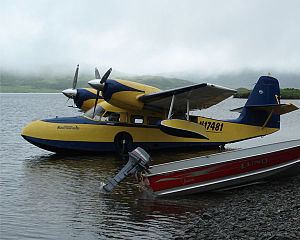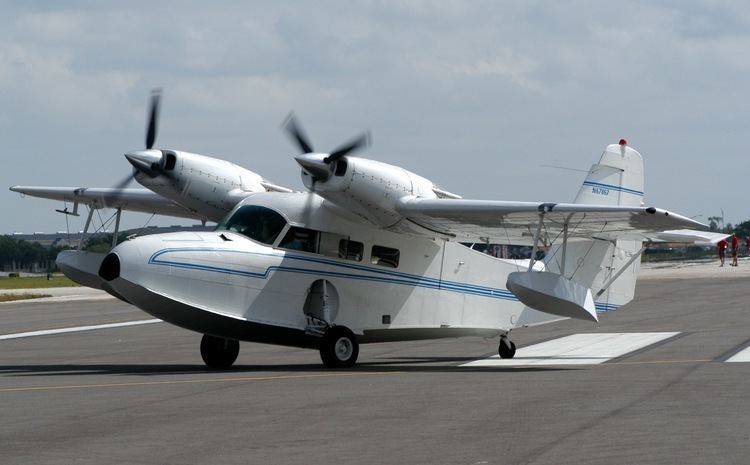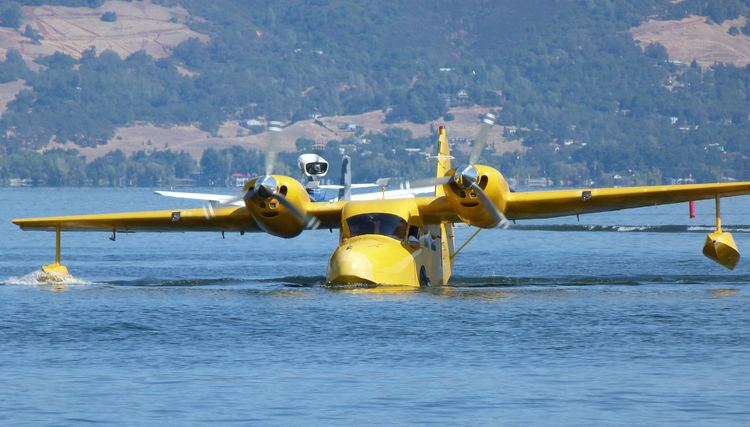Top speed 246 km/h Length 9.47 m | Wingspan 12 m Engine type Reciprocating engine | |
 | ||
Electrifly grumman g 44 widgeon maiden flight
The Grumman G-44 Widgeon is a small, five-person, twin-engine amphibious aircraft. It was designated J4F by the United States Navy and Coast Guard and OA-14 by the United States Army Air Corps and United States Army Air Forces.
Contents
- Electrifly grumman g 44 widgeon maiden flight
- The grumman g 44 widgeon aircraft has landed on copake lake in n y aug 2004
- Design and development
- Operational history
- Postwar operations
- Variants
- Military operators
- Civil operators
- Survivors
- Specifications G 44
- References

The grumman g 44 widgeon aircraft has landed on copake lake in n y aug 2004
Design and development

The Widgeon was originally designed for the civil market. It is smaller but otherwise similar to Grumman's earlier G-21 Goose, and was produced from 1941 to 1955. The aircraft was used during World War II as a small patrol and utility machine by the United States Navy, US Coast Guard and by the Royal Navy's Fleet Air Arm.

The first prototype flew in 1940, and the first production aircraft went to the United States Navy as an anti-submarine aircraft. In total, 276 were built by Grumman, including 176 for the military. During World War II, they served with the US Navy, Coast Guard, Civil Air Patrol and Army Air Force, as well as with the British Royal Navy, who gave it the service name Gosling.
Operational history
On August 1, 1942, a J4F-1 flown by US Coast Guard Patrol Squadron 212 based out of Houma, Louisiana and flown by Chief Aviation Pilot Henry White spotted and attacked a German U-boat off the coast of Louisiana. White reported the submarine sunk, and he was subsequently credited with sinking U-166 and awarded the Distinguished Flying Cross.
However, in June 2001 the wreck of U-166 was found sitting near the wreck of SS Robert E. Lee by an oil exploration team; and the sinking of U-166 on July 30 (i.e. two days before the Widgeon flight) is now credited to patrol craft PC-566 escorting the Robert E. Lee.
White's Widgeon is now thought to have made an unsuccessful attack against U-171, a Type IXC U-boat identical to U-166 that reported an air attack coincident with White's attack. U-171 was undamaged by White's attack, but was sunk four months later in the Bay of Biscay.
Postwar operations
After the war, Grumman redesigned the aircraft to make it more suitable for civilian operations. A new hull improved its water handling, and six seats were installed. A total of 76 of the new G-44A were built by Grumman, the last being delivered on January 13, 1949. Another 41 were produced under licence by the Societe de Construction Aero-Navale (SCAN) in La Rochelle, France as the SCAN-30. Most of these ended up in the United States.
McKinnon Enterprises at Sandy, Oregon converted over 70 Widgeons to "Super Widgeons." The conversion features replacing the engines with 270 hp (201 kW) Avco Lycoming GO-480-B1D flat-six piston engines, and various other modifications, including modern avionics, three-bladed propellers, larger windows, improved soundproofing, emergency exits, and increased Maximum Takeoff Weight. Retractable wingtip floats are optional.
Variants
Pacific Aerospace Engineering Corporation conversions of S.C.A.N. 30s, powered by 300 hp (220 kW) Lycoming R-680-13 radial engines. Later known as the Gannet Super Widgeon
Military operators
Civil operators
Survivors
Many Widgeons survive in private hands, in various states of restoration or storage. The aircraft continues to enjoy a considerable degree of popularity as a seaplane with many still being flown regularly, though rarely on the warbird circuit.
Specifications (G-44)
Data from War Planes of the Second World War: Volume Five: Flying Boats
General characteristics
Performance
Armament
